Sustainability Design Report: Cradle to Cradle and Project Analysis
VerifiedAdded on 2021/02/21
|11
|2021
|31
Report
AI Summary
This report provides an in-depth analysis of sustainability design, focusing on the Cradle to Cradle approach as outlined by McDonough and Braungart. It explores the core principles of this method, emphasizing eco-effectiveness over eco-efficiency and the importance of product life cycles and the integration of industrial and environmental goals. The report examines five key steps within the Cradle to Cradle approach: hazardous material reduction, material re-utilization, energy consumption reduction, water usage optimization, and ethical corporate practices. The analysis includes two case studies: Backsippans Preschool in Sweden, which exemplifies the practical application of Cradle to Cradle principles, and Venlo City Hall, showcasing sustainable architecture and design. Both projects demonstrate the benefits of the approach, including enhanced air and water quality, reduced waste, and a focus on environmental and industrial sustainability. The report concludes by highlighting the effectiveness of sustainability design in promoting product life cycles and the fusion of design, architecture, and chemistry for long-term benefits.
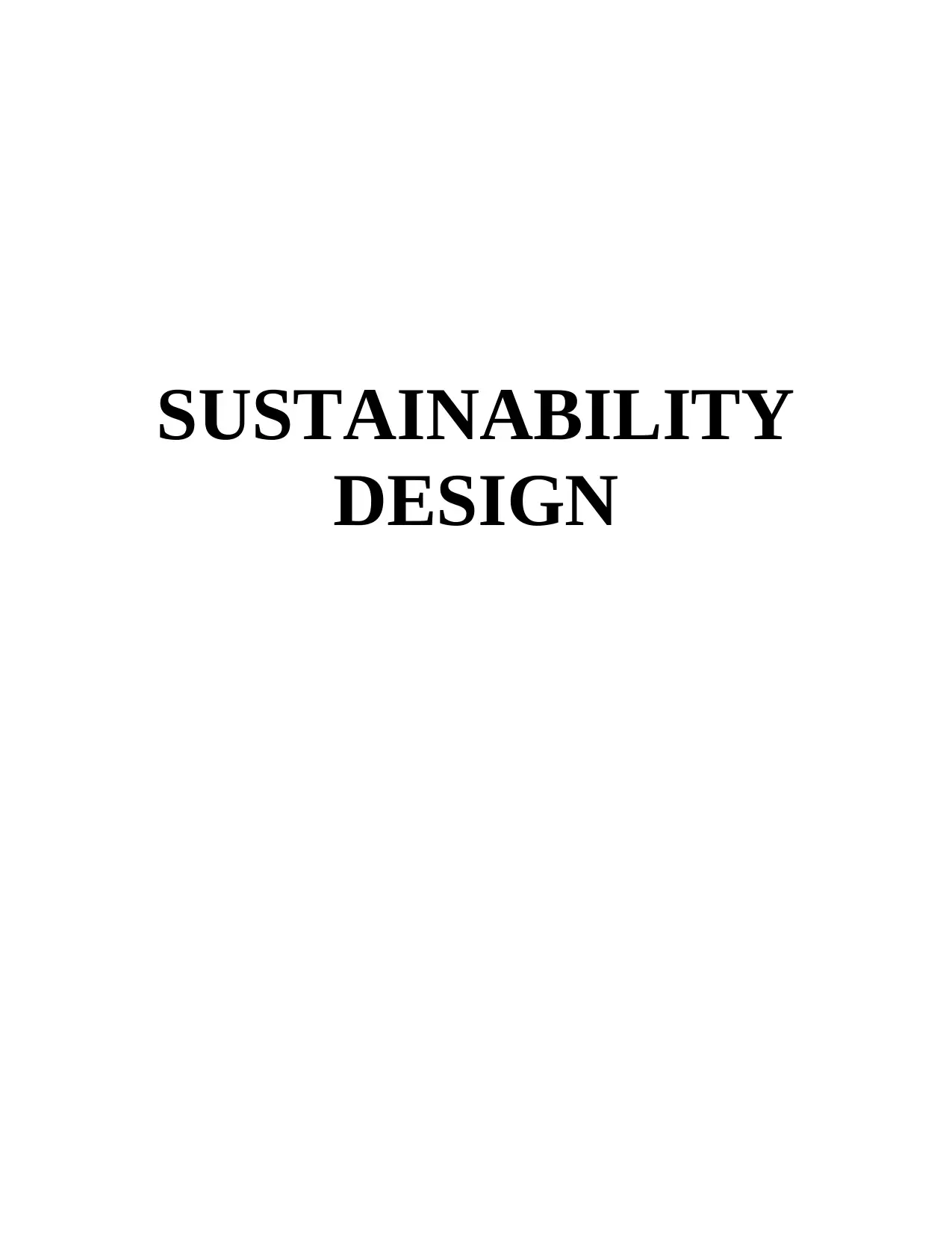
SUSTAINABILITY
DESIGN
DESIGN
Paraphrase This Document
Need a fresh take? Get an instant paraphrase of this document with our AI Paraphraser
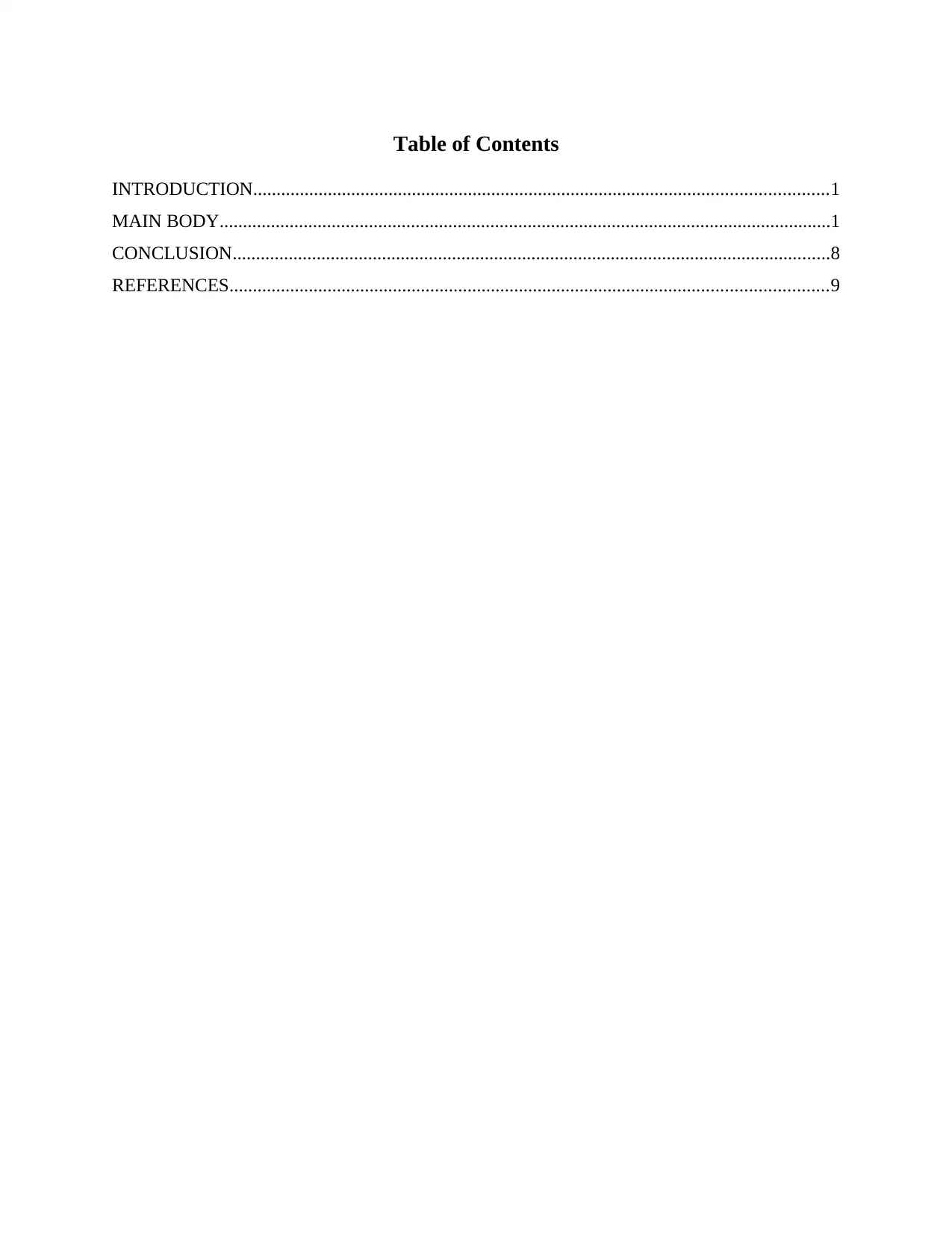
Table of Contents
INTRODUCTION...........................................................................................................................1
MAIN BODY...................................................................................................................................1
CONCLUSION................................................................................................................................8
REFERENCES................................................................................................................................9
INTRODUCTION...........................................................................................................................1
MAIN BODY...................................................................................................................................1
CONCLUSION................................................................................................................................8
REFERENCES................................................................................................................................9
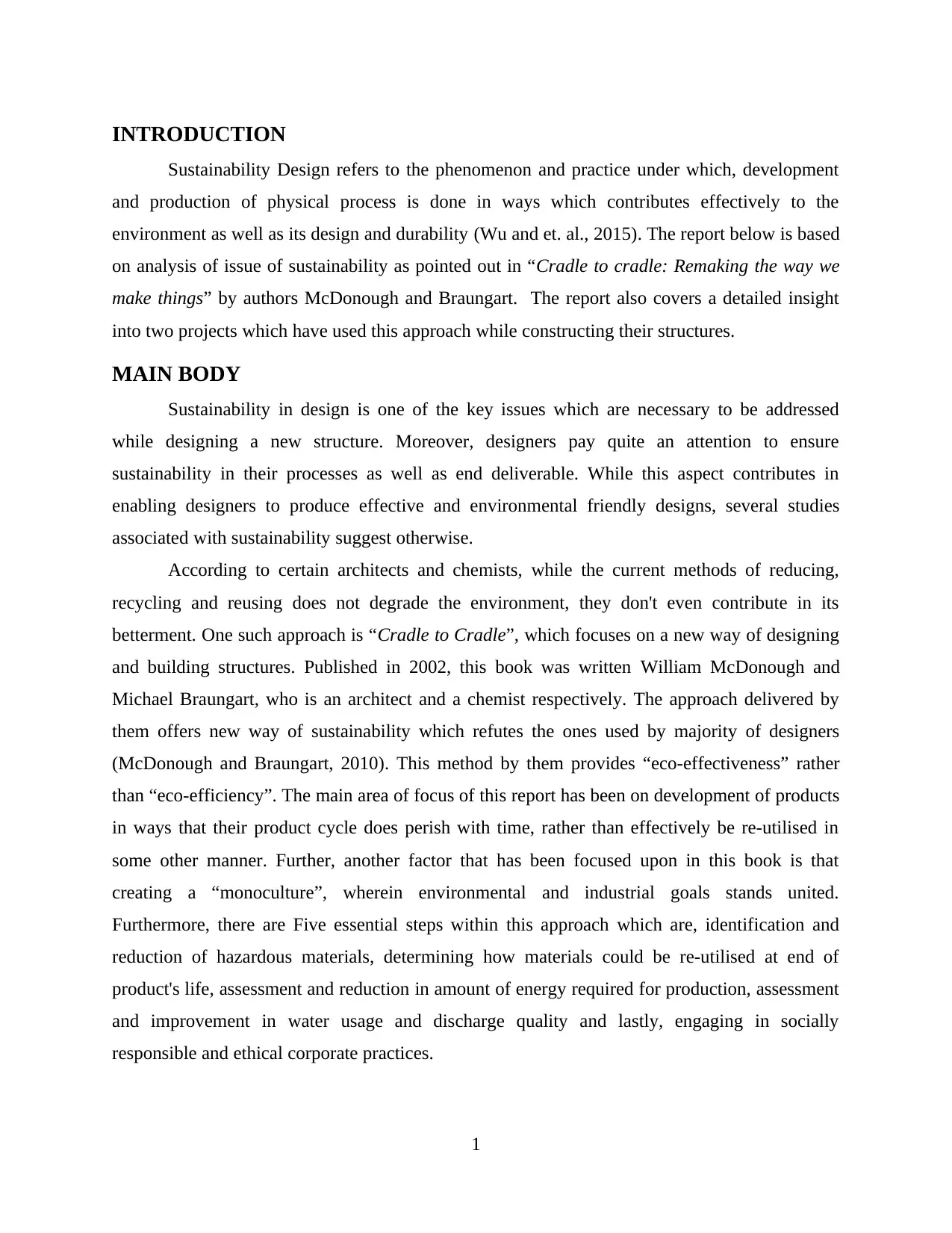
INTRODUCTION
Sustainability Design refers to the phenomenon and practice under which, development
and production of physical process is done in ways which contributes effectively to the
environment as well as its design and durability (Wu and et. al., 2015). The report below is based
on analysis of issue of sustainability as pointed out in “Cradle to cradle: Remaking the way we
make things” by authors McDonough and Braungart. The report also covers a detailed insight
into two projects which have used this approach while constructing their structures.
MAIN BODY
Sustainability in design is one of the key issues which are necessary to be addressed
while designing a new structure. Moreover, designers pay quite an attention to ensure
sustainability in their processes as well as end deliverable. While this aspect contributes in
enabling designers to produce effective and environmental friendly designs, several studies
associated with sustainability suggest otherwise.
According to certain architects and chemists, while the current methods of reducing,
recycling and reusing does not degrade the environment, they don't even contribute in its
betterment. One such approach is “Cradle to Cradle”, which focuses on a new way of designing
and building structures. Published in 2002, this book was written William McDonough and
Michael Braungart, who is an architect and a chemist respectively. The approach delivered by
them offers new way of sustainability which refutes the ones used by majority of designers
(McDonough and Braungart, 2010). This method by them provides “eco-effectiveness” rather
than “eco-efficiency”. The main area of focus of this report has been on development of products
in ways that their product cycle does perish with time, rather than effectively be re-utilised in
some other manner. Further, another factor that has been focused upon in this book is that
creating a “monoculture”, wherein environmental and industrial goals stands united.
Furthermore, there are Five essential steps within this approach which are, identification and
reduction of hazardous materials, determining how materials could be re-utilised at end of
product's life, assessment and reduction in amount of energy required for production, assessment
and improvement in water usage and discharge quality and lastly, engaging in socially
responsible and ethical corporate practices.
1
Sustainability Design refers to the phenomenon and practice under which, development
and production of physical process is done in ways which contributes effectively to the
environment as well as its design and durability (Wu and et. al., 2015). The report below is based
on analysis of issue of sustainability as pointed out in “Cradle to cradle: Remaking the way we
make things” by authors McDonough and Braungart. The report also covers a detailed insight
into two projects which have used this approach while constructing their structures.
MAIN BODY
Sustainability in design is one of the key issues which are necessary to be addressed
while designing a new structure. Moreover, designers pay quite an attention to ensure
sustainability in their processes as well as end deliverable. While this aspect contributes in
enabling designers to produce effective and environmental friendly designs, several studies
associated with sustainability suggest otherwise.
According to certain architects and chemists, while the current methods of reducing,
recycling and reusing does not degrade the environment, they don't even contribute in its
betterment. One such approach is “Cradle to Cradle”, which focuses on a new way of designing
and building structures. Published in 2002, this book was written William McDonough and
Michael Braungart, who is an architect and a chemist respectively. The approach delivered by
them offers new way of sustainability which refutes the ones used by majority of designers
(McDonough and Braungart, 2010). This method by them provides “eco-effectiveness” rather
than “eco-efficiency”. The main area of focus of this report has been on development of products
in ways that their product cycle does perish with time, rather than effectively be re-utilised in
some other manner. Further, another factor that has been focused upon in this book is that
creating a “monoculture”, wherein environmental and industrial goals stands united.
Furthermore, there are Five essential steps within this approach which are, identification and
reduction of hazardous materials, determining how materials could be re-utilised at end of
product's life, assessment and reduction in amount of energy required for production, assessment
and improvement in water usage and discharge quality and lastly, engaging in socially
responsible and ethical corporate practices.
1
⊘ This is a preview!⊘
Do you want full access?
Subscribe today to unlock all pages.

Trusted by 1+ million students worldwide
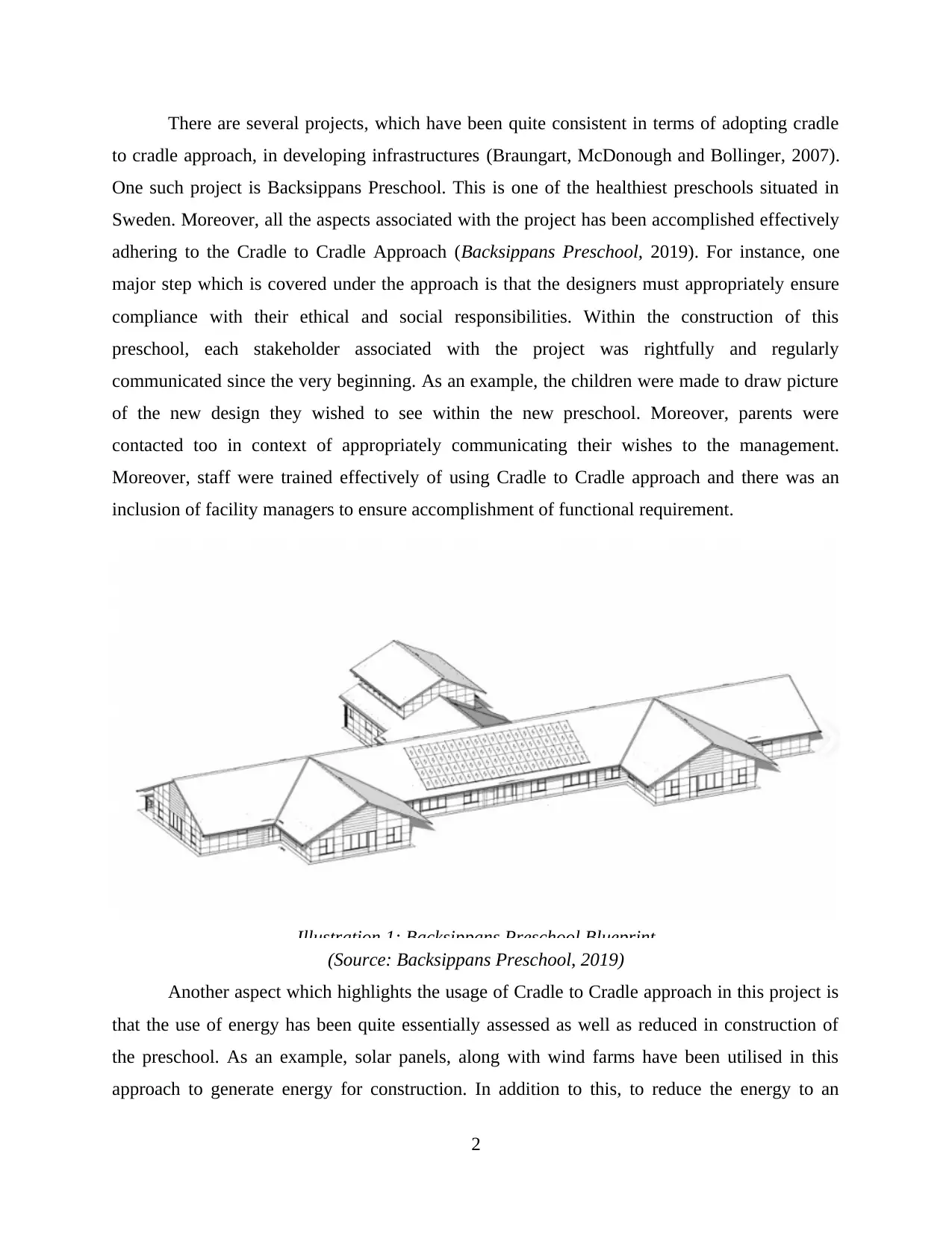
There are several projects, which have been quite consistent in terms of adopting cradle
to cradle approach, in developing infrastructures (Braungart, McDonough and Bollinger, 2007).
One such project is Backsippans Preschool. This is one of the healthiest preschools situated in
Sweden. Moreover, all the aspects associated with the project has been accomplished effectively
adhering to the Cradle to Cradle Approach (Backsippans Preschool, 2019). For instance, one
major step which is covered under the approach is that the designers must appropriately ensure
compliance with their ethical and social responsibilities. Within the construction of this
preschool, each stakeholder associated with the project was rightfully and regularly
communicated since the very beginning. As an example, the children were made to draw picture
of the new design they wished to see within the new preschool. Moreover, parents were
contacted too in context of appropriately communicating their wishes to the management.
Moreover, staff were trained effectively of using Cradle to Cradle approach and there was an
inclusion of facility managers to ensure accomplishment of functional requirement.
Illustration 1: Backsippans Preschool Blueprint
(Source: Backsippans Preschool, 2019)
Another aspect which highlights the usage of Cradle to Cradle approach in this project is
that the use of energy has been quite essentially assessed as well as reduced in construction of
the preschool. As an example, solar panels, along with wind farms have been utilised in this
approach to generate energy for construction. In addition to this, to reduce the energy to an
2
to cradle approach, in developing infrastructures (Braungart, McDonough and Bollinger, 2007).
One such project is Backsippans Preschool. This is one of the healthiest preschools situated in
Sweden. Moreover, all the aspects associated with the project has been accomplished effectively
adhering to the Cradle to Cradle Approach (Backsippans Preschool, 2019). For instance, one
major step which is covered under the approach is that the designers must appropriately ensure
compliance with their ethical and social responsibilities. Within the construction of this
preschool, each stakeholder associated with the project was rightfully and regularly
communicated since the very beginning. As an example, the children were made to draw picture
of the new design they wished to see within the new preschool. Moreover, parents were
contacted too in context of appropriately communicating their wishes to the management.
Moreover, staff were trained effectively of using Cradle to Cradle approach and there was an
inclusion of facility managers to ensure accomplishment of functional requirement.
Illustration 1: Backsippans Preschool Blueprint
(Source: Backsippans Preschool, 2019)
Another aspect which highlights the usage of Cradle to Cradle approach in this project is
that the use of energy has been quite essentially assessed as well as reduced in construction of
the preschool. As an example, solar panels, along with wind farms have been utilised in this
approach to generate energy for construction. In addition to this, to reduce the energy to an
2
Paraphrase This Document
Need a fresh take? Get an instant paraphrase of this document with our AI Paraphraser
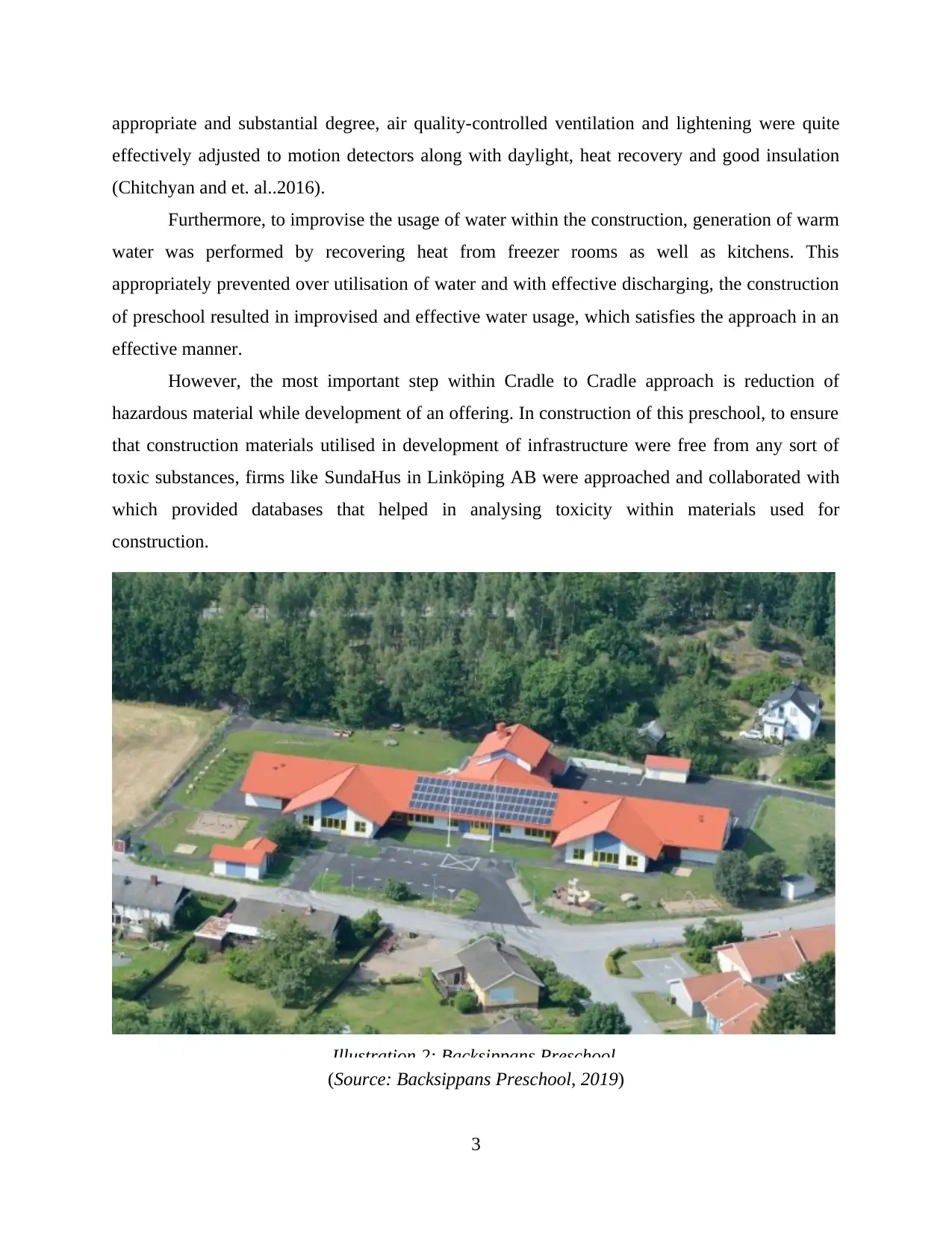
appropriate and substantial degree, air quality-controlled ventilation and lightening were quite
effectively adjusted to motion detectors along with daylight, heat recovery and good insulation
(Chitchyan and et. al..2016).
Furthermore, to improvise the usage of water within the construction, generation of warm
water was performed by recovering heat from freezer rooms as well as kitchens. This
appropriately prevented over utilisation of water and with effective discharging, the construction
of preschool resulted in improvised and effective water usage, which satisfies the approach in an
effective manner.
However, the most important step within Cradle to Cradle approach is reduction of
hazardous material while development of an offering. In construction of this preschool, to ensure
that construction materials utilised in development of infrastructure were free from any sort of
toxic substances, firms like SundaHus in Linköping AB were approached and collaborated with
which provided databases that helped in analysing toxicity within materials used for
construction.
Illustration 2: Backsippans Preschool
(Source: Backsippans Preschool, 2019)
3
effectively adjusted to motion detectors along with daylight, heat recovery and good insulation
(Chitchyan and et. al..2016).
Furthermore, to improvise the usage of water within the construction, generation of warm
water was performed by recovering heat from freezer rooms as well as kitchens. This
appropriately prevented over utilisation of water and with effective discharging, the construction
of preschool resulted in improvised and effective water usage, which satisfies the approach in an
effective manner.
However, the most important step within Cradle to Cradle approach is reduction of
hazardous material while development of an offering. In construction of this preschool, to ensure
that construction materials utilised in development of infrastructure were free from any sort of
toxic substances, firms like SundaHus in Linköping AB were approached and collaborated with
which provided databases that helped in analysing toxicity within materials used for
construction.
Illustration 2: Backsippans Preschool
(Source: Backsippans Preschool, 2019)
3
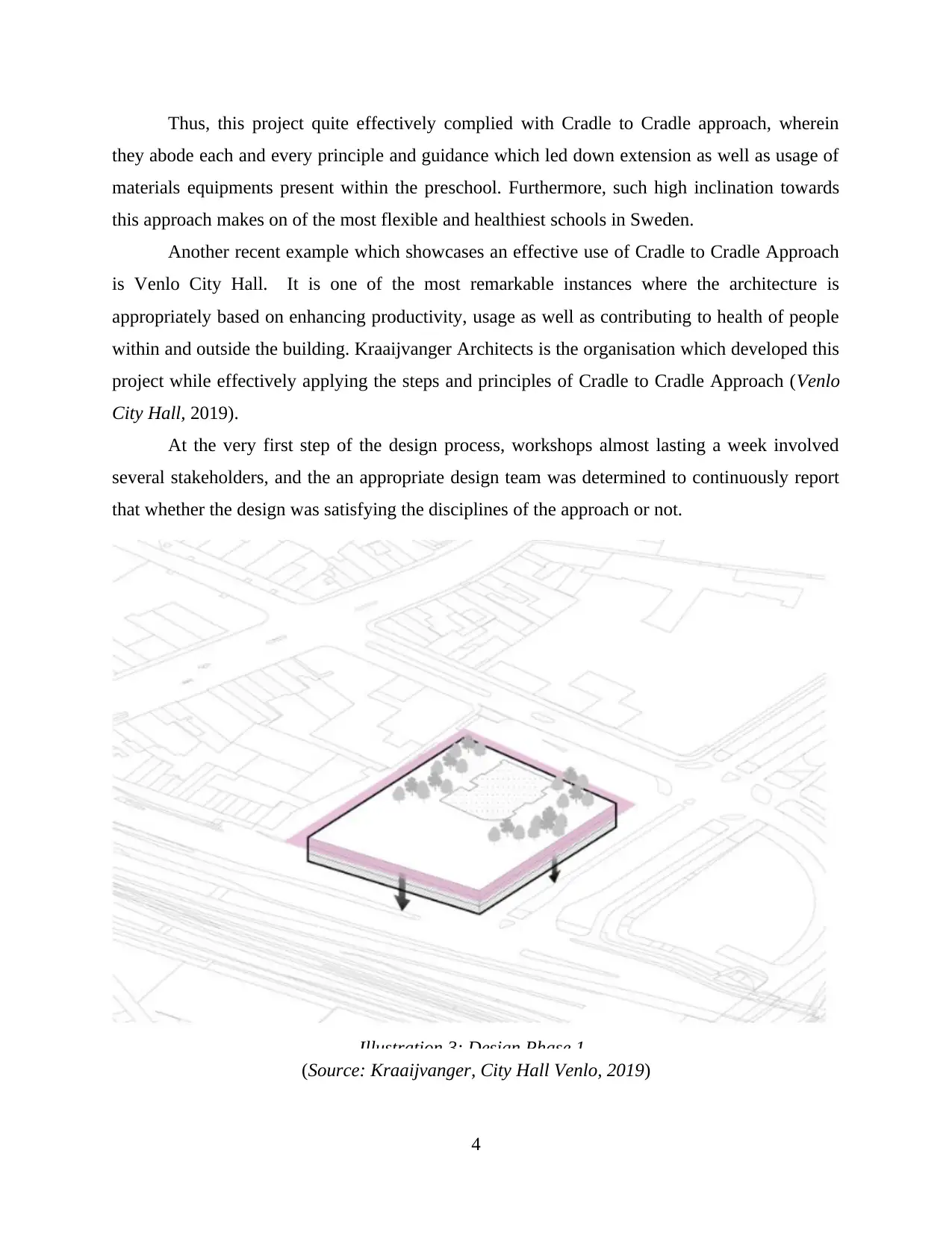
Thus, this project quite effectively complied with Cradle to Cradle approach, wherein
they abode each and every principle and guidance which led down extension as well as usage of
materials equipments present within the preschool. Furthermore, such high inclination towards
this approach makes on of the most flexible and healthiest schools in Sweden.
Another recent example which showcases an effective use of Cradle to Cradle Approach
is Venlo City Hall. It is one of the most remarkable instances where the architecture is
appropriately based on enhancing productivity, usage as well as contributing to health of people
within and outside the building. Kraaijvanger Architects is the organisation which developed this
project while effectively applying the steps and principles of Cradle to Cradle Approach (Venlo
City Hall, 2019).
At the very first step of the design process, workshops almost lasting a week involved
several stakeholders, and the an appropriate design team was determined to continuously report
that whether the design was satisfying the disciplines of the approach or not.
Illustration 3: Design Phase 1
(Source: Kraaijvanger, City Hall Venlo, 2019)
4
they abode each and every principle and guidance which led down extension as well as usage of
materials equipments present within the preschool. Furthermore, such high inclination towards
this approach makes on of the most flexible and healthiest schools in Sweden.
Another recent example which showcases an effective use of Cradle to Cradle Approach
is Venlo City Hall. It is one of the most remarkable instances where the architecture is
appropriately based on enhancing productivity, usage as well as contributing to health of people
within and outside the building. Kraaijvanger Architects is the organisation which developed this
project while effectively applying the steps and principles of Cradle to Cradle Approach (Venlo
City Hall, 2019).
At the very first step of the design process, workshops almost lasting a week involved
several stakeholders, and the an appropriate design team was determined to continuously report
that whether the design was satisfying the disciplines of the approach or not.
Illustration 3: Design Phase 1
(Source: Kraaijvanger, City Hall Venlo, 2019)
4
⊘ This is a preview!⊘
Do you want full access?
Subscribe today to unlock all pages.

Trusted by 1+ million students worldwide
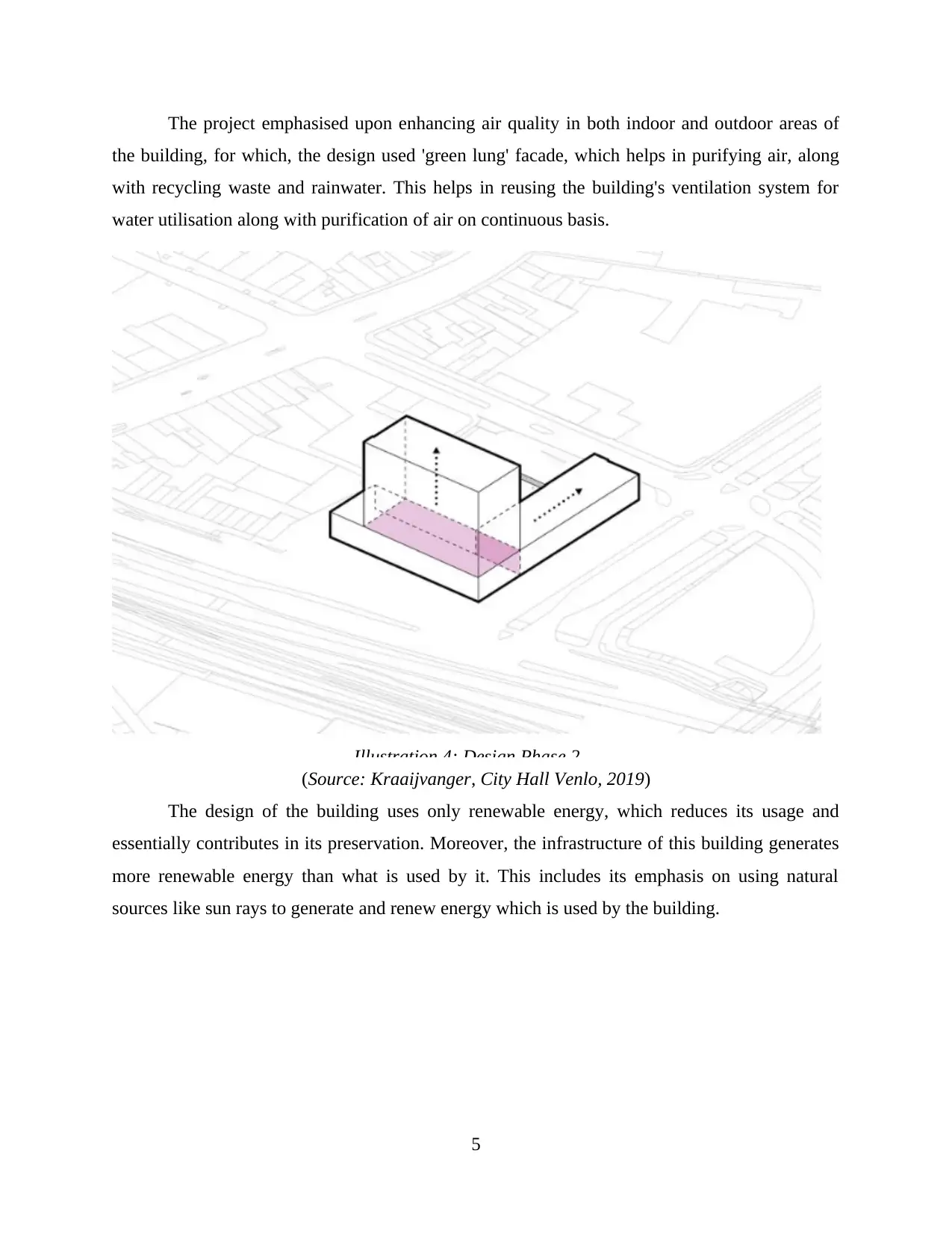
The project emphasised upon enhancing air quality in both indoor and outdoor areas of
the building, for which, the design used 'green lung' facade, which helps in purifying air, along
with recycling waste and rainwater. This helps in reusing the building's ventilation system for
water utilisation along with purification of air on continuous basis.
Illustration 4: Design Phase 2
(Source: Kraaijvanger, City Hall Venlo, 2019)
The design of the building uses only renewable energy, which reduces its usage and
essentially contributes in its preservation. Moreover, the infrastructure of this building generates
more renewable energy than what is used by it. This includes its emphasis on using natural
sources like sun rays to generate and renew energy which is used by the building.
5
the building, for which, the design used 'green lung' facade, which helps in purifying air, along
with recycling waste and rainwater. This helps in reusing the building's ventilation system for
water utilisation along with purification of air on continuous basis.
Illustration 4: Design Phase 2
(Source: Kraaijvanger, City Hall Venlo, 2019)
The design of the building uses only renewable energy, which reduces its usage and
essentially contributes in its preservation. Moreover, the infrastructure of this building generates
more renewable energy than what is used by it. This includes its emphasis on using natural
sources like sun rays to generate and renew energy which is used by the building.
5
Paraphrase This Document
Need a fresh take? Get an instant paraphrase of this document with our AI Paraphraser
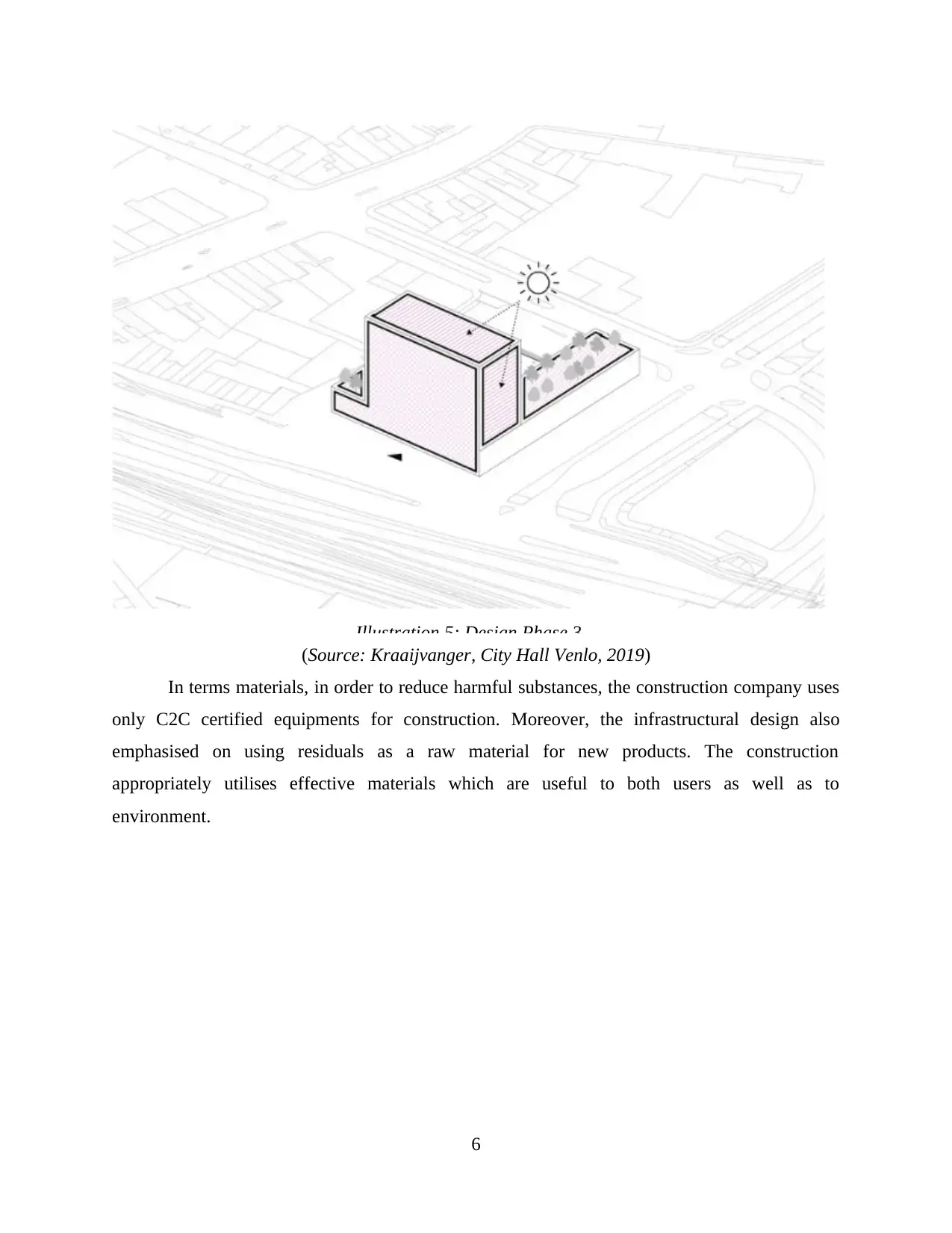
Illustration 5: Design Phase 3
(Source: Kraaijvanger, City Hall Venlo, 2019)
In terms materials, in order to reduce harmful substances, the construction company uses
only C2C certified equipments for construction. Moreover, the infrastructural design also
emphasised on using residuals as a raw material for new products. The construction
appropriately utilises effective materials which are useful to both users as well as to
environment.
6
(Source: Kraaijvanger, City Hall Venlo, 2019)
In terms materials, in order to reduce harmful substances, the construction company uses
only C2C certified equipments for construction. Moreover, the infrastructural design also
emphasised on using residuals as a raw material for new products. The construction
appropriately utilises effective materials which are useful to both users as well as to
environment.
6
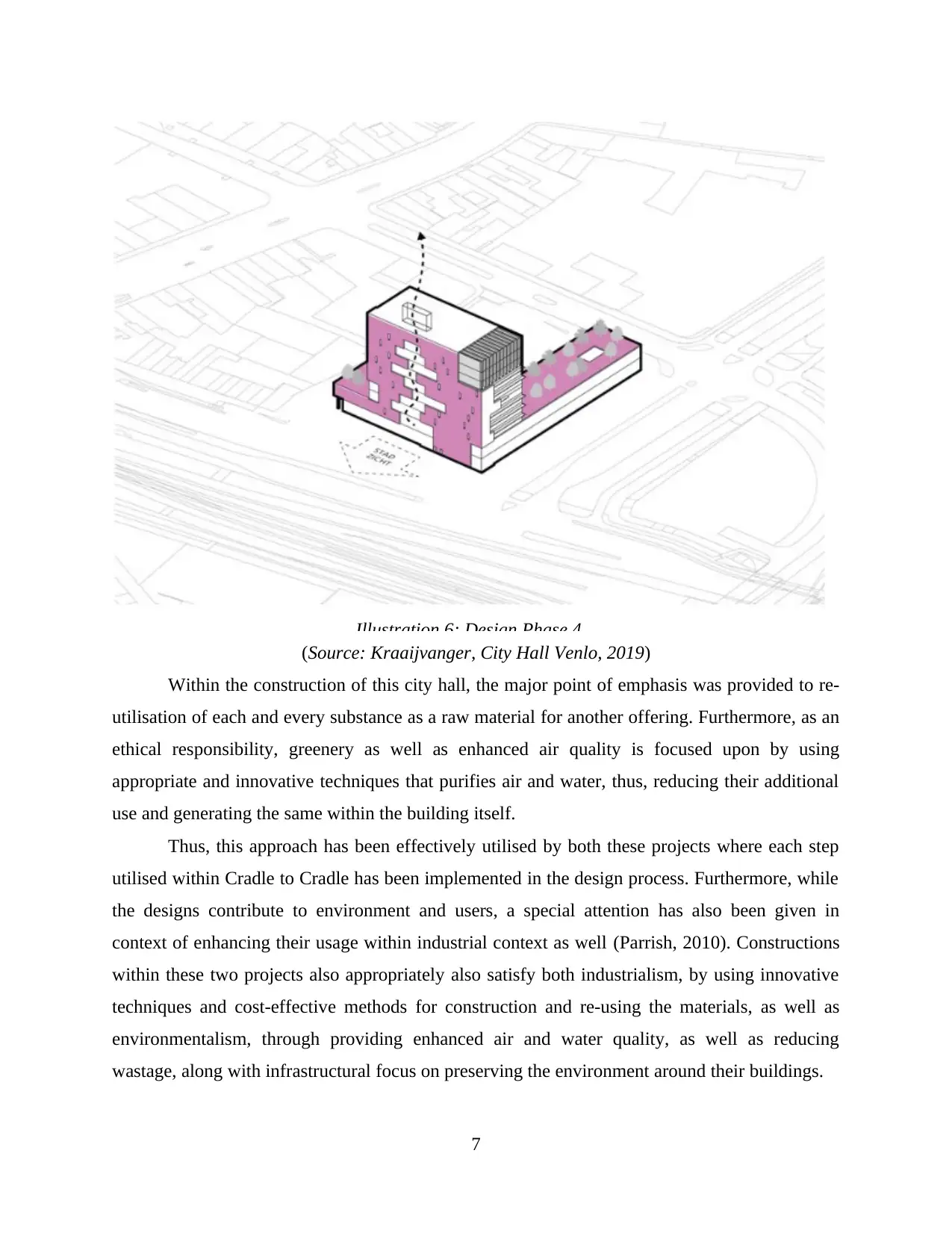
Illustration 6: Design Phase 4
(Source: Kraaijvanger, City Hall Venlo, 2019)
Within the construction of this city hall, the major point of emphasis was provided to re-
utilisation of each and every substance as a raw material for another offering. Furthermore, as an
ethical responsibility, greenery as well as enhanced air quality is focused upon by using
appropriate and innovative techniques that purifies air and water, thus, reducing their additional
use and generating the same within the building itself.
Thus, this approach has been effectively utilised by both these projects where each step
utilised within Cradle to Cradle has been implemented in the design process. Furthermore, while
the designs contribute to environment and users, a special attention has also been given in
context of enhancing their usage within industrial context as well (Parrish, 2010). Constructions
within these two projects also appropriately also satisfy both industrialism, by using innovative
techniques and cost-effective methods for construction and re-using the materials, as well as
environmentalism, through providing enhanced air and water quality, as well as reducing
wastage, along with infrastructural focus on preserving the environment around their buildings.
7
(Source: Kraaijvanger, City Hall Venlo, 2019)
Within the construction of this city hall, the major point of emphasis was provided to re-
utilisation of each and every substance as a raw material for another offering. Furthermore, as an
ethical responsibility, greenery as well as enhanced air quality is focused upon by using
appropriate and innovative techniques that purifies air and water, thus, reducing their additional
use and generating the same within the building itself.
Thus, this approach has been effectively utilised by both these projects where each step
utilised within Cradle to Cradle has been implemented in the design process. Furthermore, while
the designs contribute to environment and users, a special attention has also been given in
context of enhancing their usage within industrial context as well (Parrish, 2010). Constructions
within these two projects also appropriately also satisfy both industrialism, by using innovative
techniques and cost-effective methods for construction and re-using the materials, as well as
environmentalism, through providing enhanced air and water quality, as well as reducing
wastage, along with infrastructural focus on preserving the environment around their buildings.
7
⊘ This is a preview!⊘
Do you want full access?
Subscribe today to unlock all pages.

Trusted by 1+ million students worldwide
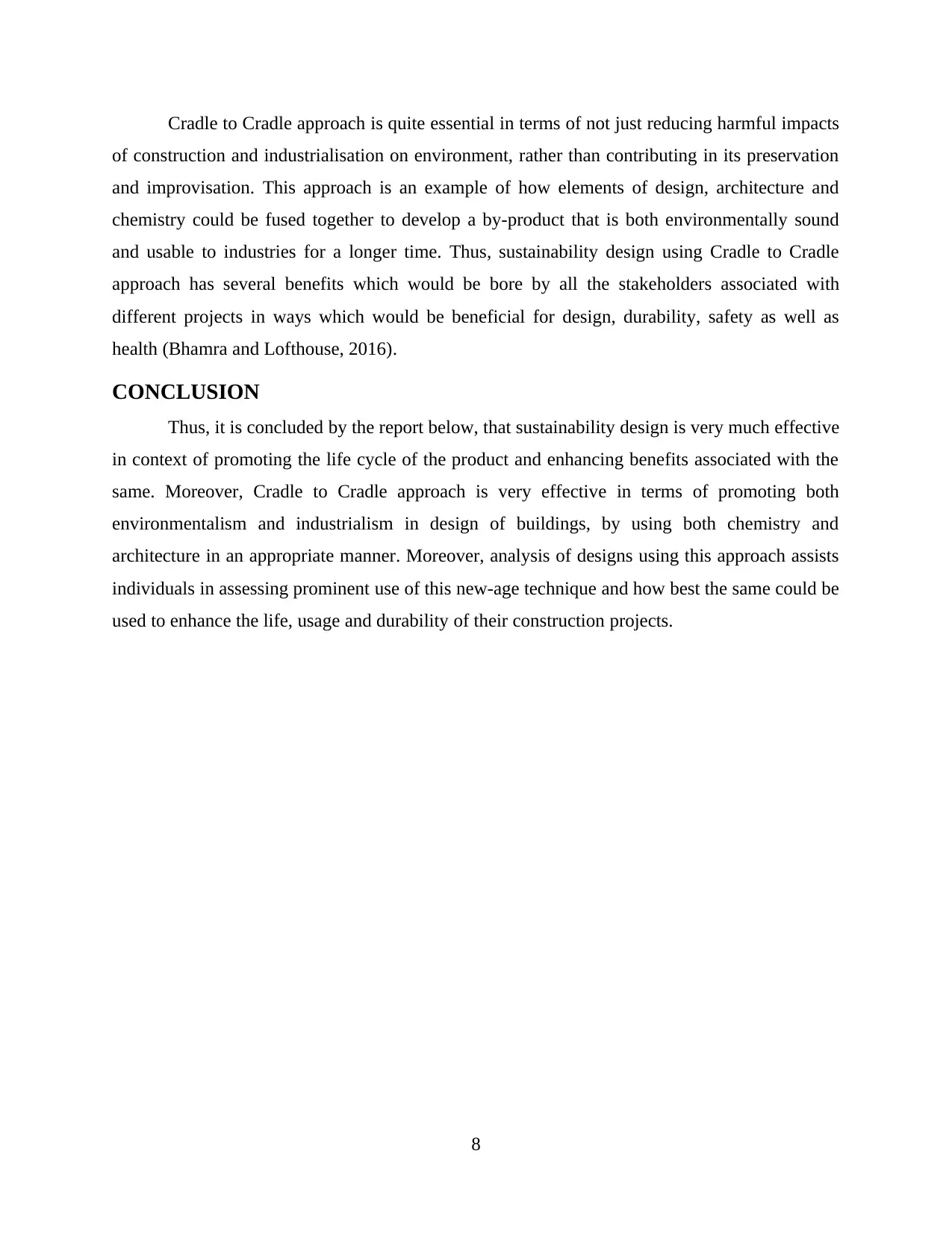
Cradle to Cradle approach is quite essential in terms of not just reducing harmful impacts
of construction and industrialisation on environment, rather than contributing in its preservation
and improvisation. This approach is an example of how elements of design, architecture and
chemistry could be fused together to develop a by-product that is both environmentally sound
and usable to industries for a longer time. Thus, sustainability design using Cradle to Cradle
approach has several benefits which would be bore by all the stakeholders associated with
different projects in ways which would be beneficial for design, durability, safety as well as
health (Bhamra and Lofthouse, 2016).
CONCLUSION
Thus, it is concluded by the report below, that sustainability design is very much effective
in context of promoting the life cycle of the product and enhancing benefits associated with the
same. Moreover, Cradle to Cradle approach is very effective in terms of promoting both
environmentalism and industrialism in design of buildings, by using both chemistry and
architecture in an appropriate manner. Moreover, analysis of designs using this approach assists
individuals in assessing prominent use of this new-age technique and how best the same could be
used to enhance the life, usage and durability of their construction projects.
8
of construction and industrialisation on environment, rather than contributing in its preservation
and improvisation. This approach is an example of how elements of design, architecture and
chemistry could be fused together to develop a by-product that is both environmentally sound
and usable to industries for a longer time. Thus, sustainability design using Cradle to Cradle
approach has several benefits which would be bore by all the stakeholders associated with
different projects in ways which would be beneficial for design, durability, safety as well as
health (Bhamra and Lofthouse, 2016).
CONCLUSION
Thus, it is concluded by the report below, that sustainability design is very much effective
in context of promoting the life cycle of the product and enhancing benefits associated with the
same. Moreover, Cradle to Cradle approach is very effective in terms of promoting both
environmentalism and industrialism in design of buildings, by using both chemistry and
architecture in an appropriate manner. Moreover, analysis of designs using this approach assists
individuals in assessing prominent use of this new-age technique and how best the same could be
used to enhance the life, usage and durability of their construction projects.
8
Paraphrase This Document
Need a fresh take? Get an instant paraphrase of this document with our AI Paraphraser
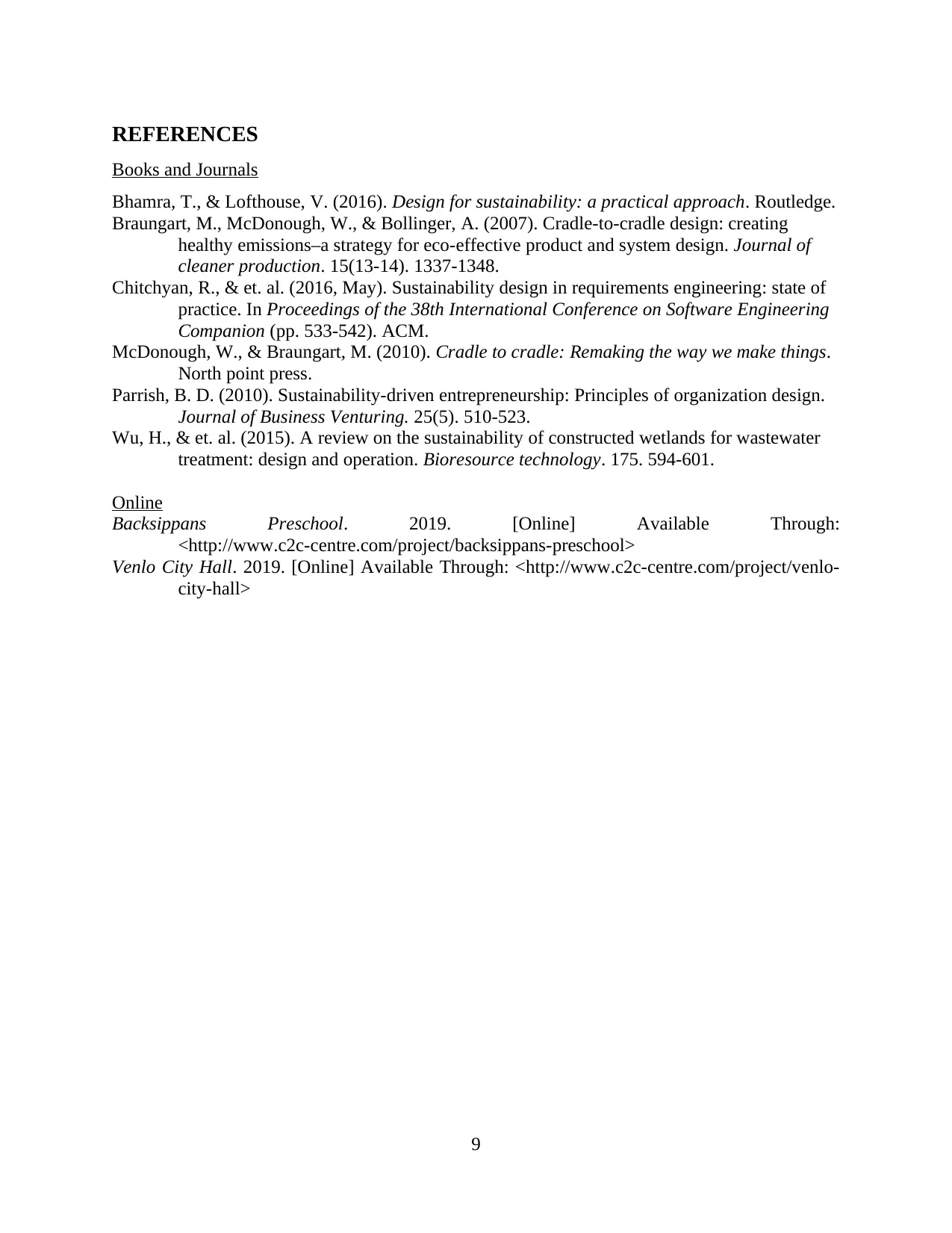
REFERENCES
Books and Journals
Bhamra, T., & Lofthouse, V. (2016). Design for sustainability: a practical approach. Routledge.
Braungart, M., McDonough, W., & Bollinger, A. (2007). Cradle-to-cradle design: creating
healthy emissions–a strategy for eco-effective product and system design. Journal of
cleaner production. 15(13-14). 1337-1348.
Chitchyan, R., & et. al. (2016, May). Sustainability design in requirements engineering: state of
practice. In Proceedings of the 38th International Conference on Software Engineering
Companion (pp. 533-542). ACM.
McDonough, W., & Braungart, M. (2010). Cradle to cradle: Remaking the way we make things.
North point press.
Parrish, B. D. (2010). Sustainability-driven entrepreneurship: Principles of organization design.
Journal of Business Venturing. 25(5). 510-523.
Wu, H., & et. al. (2015). A review on the sustainability of constructed wetlands for wastewater
treatment: design and operation. Bioresource technology. 175. 594-601.
Online
Backsippans Preschool. 2019. [Online] Available Through:
<http://www.c2c-centre.com/project/backsippans-preschool>
Venlo City Hall. 2019. [Online] Available Through: <http://www.c2c-centre.com/project/venlo-
city-hall>
9
Books and Journals
Bhamra, T., & Lofthouse, V. (2016). Design for sustainability: a practical approach. Routledge.
Braungart, M., McDonough, W., & Bollinger, A. (2007). Cradle-to-cradle design: creating
healthy emissions–a strategy for eco-effective product and system design. Journal of
cleaner production. 15(13-14). 1337-1348.
Chitchyan, R., & et. al. (2016, May). Sustainability design in requirements engineering: state of
practice. In Proceedings of the 38th International Conference on Software Engineering
Companion (pp. 533-542). ACM.
McDonough, W., & Braungart, M. (2010). Cradle to cradle: Remaking the way we make things.
North point press.
Parrish, B. D. (2010). Sustainability-driven entrepreneurship: Principles of organization design.
Journal of Business Venturing. 25(5). 510-523.
Wu, H., & et. al. (2015). A review on the sustainability of constructed wetlands for wastewater
treatment: design and operation. Bioresource technology. 175. 594-601.
Online
Backsippans Preschool. 2019. [Online] Available Through:
<http://www.c2c-centre.com/project/backsippans-preschool>
Venlo City Hall. 2019. [Online] Available Through: <http://www.c2c-centre.com/project/venlo-
city-hall>
9
1 out of 11
Related Documents
Your All-in-One AI-Powered Toolkit for Academic Success.
+13062052269
info@desklib.com
Available 24*7 on WhatsApp / Email
![[object Object]](/_next/static/media/star-bottom.7253800d.svg)
Unlock your academic potential
Copyright © 2020–2025 A2Z Services. All Rights Reserved. Developed and managed by ZUCOL.





